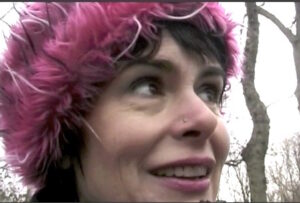
When I tell people I’m from Detroit, they get excited and want to hear about the “new” Detroit, the “Great Comeback City” as it is now touted on signs at the Detroit Metropolitan Airport. There’s also much interest in the growing art scene here. For me, Detroit is about the people, who are the character, spirit and soul of the city, and some Detroiters respond to the notion of a “Comeback City” in this way: “comeback for who?“
A little background: In 2001, I ditched my car and my job in Los Angeles and moved back to Detroit, the city where I was born. Detroit had the gritty vibe of 1990’s downtown L.A. (my previous residence) and an open and friendly small art community. The city was in serious disrepair with boarded houses along most blocks. Tall grasses filled open lots and wild pheasants darted about – a rural/urban mix with an undoubtedly desolate feeling.
A few years later the first of many New York Times articles reported on the opportunities (vacant buildings, cheap housing) for artists. International photographers parachuted in to snap shots of crumbling buildings and distribute them on social media or as slick coffee table books. The term “ruin porn” took hold. It wasn’t untrue: there are still miles of crumbling and boarded up structures. But that Detroit became the symbol of a failed city was painful. Then the city declared bankruptcy and an appointed (not elected) Emergency Manager was put in place, adding insult to injury.
Fast forward and we are out of bankruptcy and investors are buying up properties. The city has improved services such as streetlight repair and burnt housing demolition. But the influx of developers and investment focus on downtown and the adjacent Midtown area, creating venues, often with significant tax breaks, that cater to a higher-income clientele. Meanwhile long-time residents feel city administration is ignoring the vast expanse of Detroit’s neighborhoods.
Many fear, reasonably so, a loss of local character, flavor, visual uniqueness and affordable housing/retail spaces. Goodwells Natural Food Store, one of the few black-owned natural food businesses in Detroit closed in 2016 due to competition from new neighbors like Whole Foods Market. Skyrocketing rents have driven out even the legendary Henry the Hatter, the iconic men’s haberdashery, from its longtime downtown location (the store has now re-opened in Detroit’s Eastern Market).
On the other side of the debate, pro-gentrifiers argue it brings increased tax revenue, more vitality, more tourism dollars for local retail and restaurants. They frequently substitute ‘gentrification’ with revitalization. Undeniably there are now far more people visiting and enjoying the downtown and Midtown areas. The message is that white people (and white-led businesses) are moving back to the inner city, thus the question, “Great Comeback” for who?
Around 2011, I saw a full-page ad for Shinola in the New York Times Sunday paper that gave me pause. The formerly non-Detroit company had opened a store in Midtown and was using the manufacturing history of the city as a marketing device, prominently stamping “Detroit” under its name and claiming its luxury goods as American Made. The ad’s blatant cultural appropriation seemed like a significant tide turner: a business other than automotive actually identifying as Detroit-proud to sell its product to the world.
The first article I present as Detroit Editor of the NAE is by artist Rebekah Modrak. Her essay on Shinola, with original photographs, is both opinion piece and art project. I think you will find it fascinating and provocative.
Melanie Manos’ interdisciplinary practice uses the body, humor, and absurdity to address economic instability and gender discrimination. She teaches at the University of Michigan Stamps School of Art and Design.
Volume 33.no.1 September / October 2018 p 6

Hi Melanie,
I found your comprehensive overview of Detroit very readable. I look forward to reading more of your writing.
In the late 80s I spent a few weeks in Detroit, where everyone told me that Detroit was having a comeback, but I think not, as its abandonment was still to go on and get worse. In that period I looked at it as a city-wide museum with one area down by the riverfront newly built up with fancy hotels in sharp contrast to the many boarded up houses and empty streets in other areas. There was an antiquated ferry to Belle Isle, which had an amusement park with attractions from the 50s – it was quite an experience even 30 years ago. Though the decay and poverty were very evident and sad, it was also a very beautiful cultural experience. Detroit was unique, it wasn’t the same as every other American city; it had it’s own breath of air and unique style.
This sounds like a possibly paid nostalgic comment by Detroit’s mayor Mike Duggan. Yes, Detroit is a sort of museum, where much history is encased in its boundaries. Fortunately the art scene is beginning to thrive once again. I look forward to more writings from Melanie Manos.
There was no mention of the the Charles H. Wright Museum of African American History in Detroit that opened in 1965 and is now celebrating 50 years of bringing the rich culture and history of African Americans to the public. It is no small miracle that this museum resisted in those dark years of Detroit’s downfall, while today it has over 500,000 visitors a year.